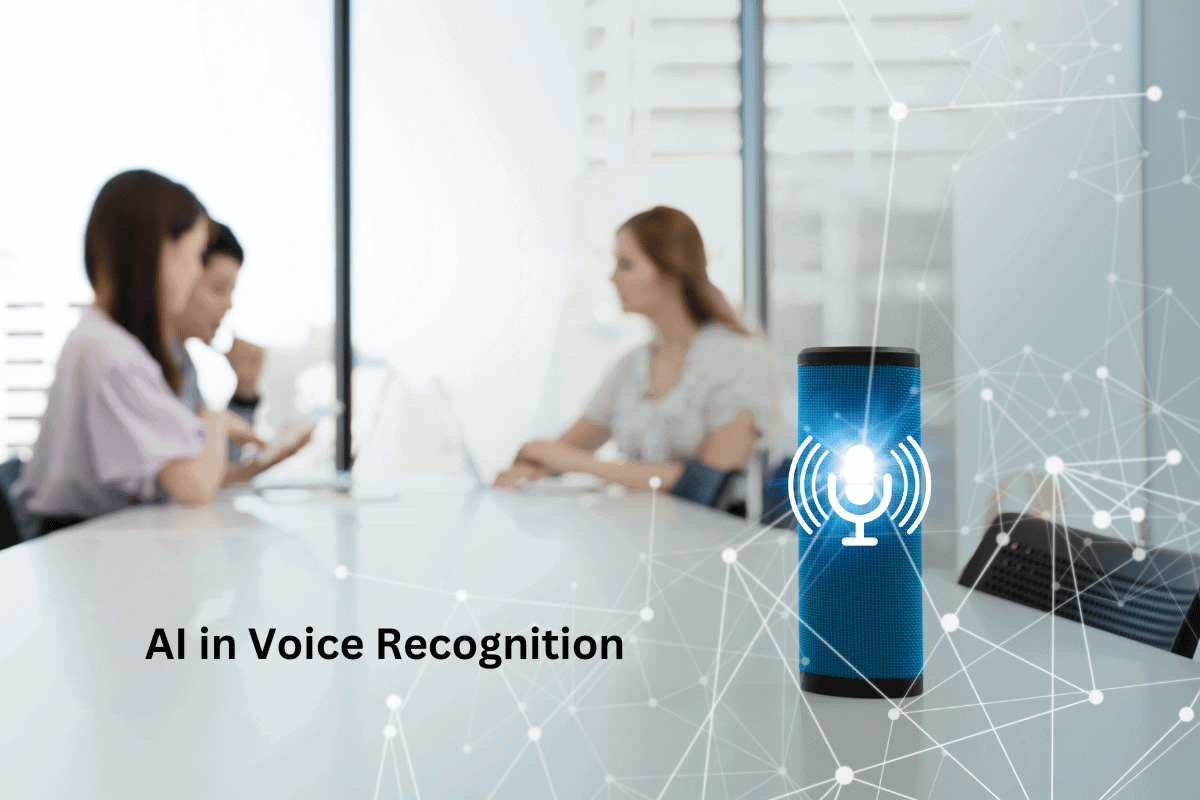AI in Voice Recognition: A Comprehensive Overview
Voice recognition technology has made monumental strides in recent years, thanks to the integration of Artificial Intelligence (AI).
Imagine a world where your voice can unlock secure systems, seamlessly control your smart home, and even assist in medical diagnoses.
The intersection of AI and voice recognition is reshaping how we interact with technology, but the implications reach far beyond convenience.
As you explore the facets of AI in voice recognition, you’ll uncover its profound impact on communication, privacy, and the very essence of human-machine interaction.
Key Takeaways
- Evolution of voice technology from HMM to neural networks to machine learning has revolutionized accuracy and efficiency.
- AI enables personalized interactions, speaker identification, and context awareness for human-like qualities in voice recognition.
- Advantages include continuous voice pattern analysis, understanding emotions, efficient data processing, and natural interactions.
- Virtual assistants optimize productivity, learn from interactions, offer personalized assistance, engage users, and streamline tasks efficiently.
Evolution of Voice Recognition Technology
Voice recognition technology has undergone significant advancements over the years, revolutionizing the way we interact with devices. The evolutionary milestones in voice recognition technology have been marked by remarkable technological advancements that have enhanced the accuracy and efficiency of this technology.
One of the key evolutionary milestones in voice recognition technology was the development of Hidden Markov Models (HMM) in the 1970s. HMM allowed for the statistical modeling of speech signals, enabling more accurate recognition of spoken words. This laid the foundation for the subsequent advancements in voice recognition technology.
The introduction of neural networks in the 1980s was another pivotal moment in the evolution of voice recognition technology. Neural networks enabled the creation of more sophisticated speech recognition systems that could learn and adapt from data, improving their accuracy and performance over time.
The integration of machine learning algorithms in voice recognition systems in the 2000s further enhanced their capabilities. These algorithms allowed voice recognition systems to analyze vast amounts of data to improve speech recognition accuracy and enable more natural language processing.
Role of Artificial Intelligence in Speech
In the realm of speech technology, Artificial Intelligence plays a crucial role in enhancing the accuracy and efficiency of voice recognition systems through advanced algorithms and neural network architectures. AI in speech involves various intricate processes that contribute to the overall functionality and performance of voice-based systems:
- Speech Synthesis: AI enables the generation of human-like speech patterns through text-to-speech technology, allowing for natural and coherent interactions between users and machines.
- Emotional Analysis: By leveraging AI, voice recognition systems can analyze the emotional content of spoken words, enabling more personalized and empathetic interactions.
- Speaker Identification: Through AI algorithms, systems can accurately identify individual speakers based on unique vocal characteristics, enhancing security and personalization.
- Context Awareness: AI facilitates the understanding of contextual cues in speech, enabling systems to adapt responses based on the specific situation or environment.
These components highlight the multifaceted role of Artificial Intelligence in speech technology, showcasing its ability to not only recognize and transcribe speech but also to imbue systems with human-like qualities such as emotion recognition and contextual understanding. By integrating AI into speech processing, voice recognition systems can deliver more intuitive, efficient, and tailored user experiences.
Advantages of AI in Voice Technology
Artificial Intelligence revolutionizes voice technology by empowering systems with advanced capabilities that enhance accuracy, efficiency, and user experience in speech recognition. Improved accuracy is a key advantage of AI in voice technology. Through machine learning algorithms, AI can continuously analyze voice patterns and adapt to variations, leading to more precise transcription of spoken words. This enhanced accuracy minimizes errors and improves the overall quality of voice recognition systems.
Additionally, AI enhances user experience by enabling more natural interactions with voice technology. Advanced AI algorithms can understand context, tone, and even emotions in speech, allowing for more personalized and intuitive responses. This level of sophistication creates a more engaging and user-friendly experience, making interactions with voice-enabled devices more seamless and enjoyable.
Moreover, AI in voice technology enables efficient processing of large volumes of data in real-time. By leveraging AI capabilities such as natural language processing and machine learning, voice recognition systems can quickly interpret and respond to user commands, resulting in faster response times and improved overall efficiency.
Virtual Assistants and AI Integration
You need to understand the significant benefits that virtual assistants offer in conjunction with AI technology for seamless integration.
Virtual assistants can enhance productivity by providing quick access to information, scheduling tasks, and automating repetitive processes.
The integration of AI allows these assistants to learn from user interactions, improving their responses and performance over time.
Virtual Assistant Benefits
Numerous benefits arise from integrating virtual assistants with AI, enhancing efficiency and user experience in various applications. When considering the advantages, think of:
- Personalized Assistance: Tailoring responses to individual preferences.
- User Engagement: Keeping users involved through interactive conversations.
- Efficiency Optimization: Streamlining tasks and providing quick solutions.
- Customer Satisfaction: Enhancing the overall experience for customers.
AI for Seamless Integration
Incorporating AI into virtual assistants facilitates seamless integration, enhancing functionality and user experience across various platforms. However, achieving seamless integration poses challenges such as interoperability between different AI systems and devices.
Ensuring compatibility with various languages and dialects also presents a hurdle due to language compatibility limitations. To address these issues, developers are working on creating standardized protocols and frameworks that enable different AI systems to communicate effectively.
Additionally, advancements in natural language processing and machine learning algorithms are key in enhancing the adaptability of virtual assistants to diverse linguistic contexts. By overcoming seamless integration challenges and language compatibility limitations, AI-powered virtual assistants can offer users a more cohesive and personalized experience across different technologies and applications.
Natural Language Processing Advancements
You must acknowledge the significant strides made in Syntax Analysis Progress and Semantic Understanding Improvements within Natural Language Processing Advancements.
These advancements have refined the way machines interpret and process human language, enabling more accurate and contextually relevant interactions.
Embracing these developments is vital for enhancing voice recognition systems’ capabilities and bridging the gap between man and machine communication.
Syntax Analysis Progress
Significant advancements have been made in the syntax analysis progress of natural language processing, enhancing the understanding and interpretation of spoken language by AI systems. The evolution in this area has revolutionized how AI comprehends linguistic patterns and structures.
Here are four key developments:
- Dependency parsing accuracy has notably improved, allowing AI to better identify relationships between words.
- Enhanced part-of-speech tagging precision aids in determining the grammatical function of each word in a sentence.
- Syntax tree generation algorithms have become more efficient, enabling quicker analysis of sentence structures.
- Deep learning models, such as recurrent neural networks, have been increasingly utilized to extract complex syntactic features from text data.
Semantic Understanding Improvements
Enhancing semantic understanding in natural language processing involves refining AI systems’ ability to grasp the meaning and context of spoken or written language through advanced algorithms and deep learning techniques. Contextual understanding is crucial as it enables AI to interpret words based on the surrounding text, leading to more accurate comprehension.
Semantic processing focuses on extracting the intended meaning from phrases, considering nuances and ambiguities within language constructs. Cognitive reasoning plays a key role in enhancing language comprehension by allowing AI systems to infer implications and draw logical conclusions from the information presented.
Machine Learning Algorithms in Voice Recognition
Machine learning algorithms play a pivotal role in the intricate process of voice recognition technology. These algorithms utilize various techniques to accurately interpret and transcribe spoken language. Here are some key aspects related to machine learning algorithms in voice recognition:
- Feature Extraction Techniques: Machine learning algorithms rely on feature extraction techniques to identify and extract relevant information from speech data. These techniques help in capturing essential characteristics of the audio signal, such as frequency components and spectrogram patterns.
- Speech Data Preprocessing: Before feeding the data into the machine learning models, speech data preprocessing is essential. This involves tasks like noise reduction, normalization, and segmentation to enhance the quality of the input data, which in turn improves the accuracy of the recognition process.
- Deep Learning Models: Deep learning models, such as recurrent neural networks (RNNs) and convolutional neural networks (CNNs), are commonly used in voice recognition systems. These models excel at learning intricate patterns and dependencies within the speech data, enabling more precise transcription.
- Acoustic Modeling Techniques: Acoustic modeling plays a crucial role in matching input audio features to phonetic units. Machine learning algorithms employ acoustic modeling techniques to map acoustic signals to linguistic units, facilitating accurate transcription and interpretation of spoken language.
Accuracy and Efficiency in Speech Interpretation
When it comes to speech interpretation, precision is paramount for accurate communication.
The speed of interpretation also plays a crucial role in the efficiency of voice recognition systems.
These two factors, precision, and speed, are key elements in determining the effectiveness of AI in speech interpretation.
Precision in Speech Recognition
To achieve optimal precision in speech recognition, it’s crucial to focus on enhancing both the accuracy and efficiency in speech interpretation. When striving for improved accuracy, advanced language models play a pivotal role in deciphering complex linguistic nuances. Here are key factors to consider:
- Acoustic Modeling: Fine-tuning acoustic models refines speech signal processing.
- Language Adaptation: Adapting language models to specific dialects enhances recognition.
- Speaker Diarization: Identifying speakers aids in context-based interpretation.
- Noise Reduction Techniques: Employing noise reduction algorithms sharpens recognition in varied environments.
These strategies collectively contribute to the precision of speech recognition systems by ensuring accurate and efficient interpretation.
Speed of Interpretation
Enhancing the speed of interpretation in speech recognition systems requires a meticulous balance between accuracy and efficiency through advanced processing techniques and algorithm optimization. Interpretation speed directly impacts user experience, making real-time analysis crucial for communication efficiency.
By leveraging deep learning models and neural networks, speech recognition systems can rapidly process spoken language, enhancing responsiveness. Efficient use of resources, such as cloud computing and parallel processing, further accelerates interpretation without compromising accuracy.
Optimizing algorithms for quick decision-making based on contextual cues refines the speed of interpretation. Continuous refinement through data-driven insights and feedback loops ensures that speech recognition systems deliver swift and precise interpretations, ultimately improving user satisfaction and communication effectiveness.
Voice Biometrics for Enhanced Security
By implementing voice biometrics, organizations can significantly enhance their security measures through the unique and distinct characteristics of an individual’s voice. Voice biometrics work by analyzing various factors such as vocal tract length, pitch, cadence, and pronunciation to create a digital representation of a person’s voice. This technology offers a high level of security due to the difficulty of replicating these intricate voice patterns.
Here are some key aspects of voice biometrics for enhanced security:
- Individualized Identification: Voice biometrics provide a personalized security feature, as each person’s voice is unique, making it challenging for unauthorized users to gain access.
- Continuous Authentication: The technology allows for ongoing authentication during a conversation or transaction, ensuring that the authorized user remains the same throughout the interaction.
- Anti-Spoofing Measures: Advanced voice biometric systems have mechanisms in place to detect and prevent spoofing attempts, such as using recorded voices or voice synthesis.
- Integration with Multi-Factor Authentication: Voice biometrics can be integrated with other authentication methods like passwords or fingerprints to create a robust security framework that enhances overall protection.
Voice biometrics offer a sophisticated and reliable approach to security enhancement, leveraging the distinctiveness of an individual’s voice to fortify access control and authentication processes.
Industry Applications of AI Voice Technology
The application of AI voice technology across various industries is revolutionizing the way organizations interact with users and streamline processes. In healthcare diagnostics, AI voice technology is being utilized to enhance patient care and optimize workflows. Voice-powered assistants can transcribe doctor-patient interactions accurately, allowing healthcare professionals to focus more on patient care rather than administrative tasks. Moreover, AI voice technology can analyze speech patterns and tones to help in diagnosing certain conditions, such as neurological disorders or mental health issues.
In customer service, AI voice technology is transforming the way businesses handle inquiries and provide support to customers. Automated voice systems powered by AI can efficiently route calls to the appropriate department or provide self-service options, reducing wait times and improving overall customer satisfaction. Additionally, AI voice technology can be used to analyze customer interactions, providing valuable insights for businesses to enhance their products or services based on customer feedback.
Challenges and Limitations in Voice Recognition
Incorporating AI voice technology in various industries has unveiled significant challenges and limitations in voice recognition systems that demand innovative solutions for further advancement. When it comes to improving accuracy and overcoming noise interference, voice recognition technology faces several hurdles that must be addressed:
- Ambient Noise: Background noise from various sources can significantly impact the accuracy of voice recognition systems, making it challenging to distinguish between the user’s voice and surrounding sounds.
- Speaker Variability: Differences in accents, speech patterns, and vocal characteristics among individuals pose a challenge for voice recognition systems to accurately identify and interpret spoken commands.
- Vocabulary Limitations: Voice recognition systems may struggle with recognizing less common words, technical terms, or specialized vocabulary, affecting the overall accuracy of speech-to-text conversion.
- Security Concerns: Vulnerabilities in voice recognition systems can lead to security breaches, as voice biometrics may be susceptible to spoofing attacks or unauthorized access attempts.
Addressing these challenges through advanced machine learning algorithms, enhanced noise cancellation techniques, and robust security measures will be crucial for the future development of AI-driven voice technology. Achieving higher accuracy rates and minimizing the impact of noise interference will pave the way for more seamless and reliable voice recognition systems across diverse applications.
Future Trends in Ai-Driven Voice Technology
To stay ahead in the rapidly evolving landscape of AI-driven voice technology, understanding emerging trends is crucial for maximizing the potential of voice recognition systems. As technology advances, several key trends are shaping the future of AI-driven voice technology.
Here is a table summarizing the upcoming trends in AI-driven voice technology:
| Trends | Description | Impact |
|---|---|---|
| Ethical Implications | With the increasing use of voice data, ethical considerations are gaining importance. | Companies need to address privacy concerns. |
| Privacy Concerns | Safeguarding user data is paramount for user trust and regulatory compliance. | Stricter data protection regulations may impact technology development. |
| User Acceptance | Understanding user needs and preferences is crucial for widespread adoption. | Improving user experience will drive acceptance rates. |
| Adoption Rates | The speed at which users adopt AI-driven voice technology is a key metric for success. | Enhancing convenience and functionality will boost adoption. |
Keeping an eye on these trends will be essential for developers and businesses looking to leverage AI-driven voice technology effectively. Stay informed and adaptable to harness the full potential of these advancements.
Ethical Considerations in Voice Data Usage
Considering the ethical implications of utilizing voice data is paramount in the development and deployment of AI-driven voice technology. In the realm of voice data usage, several key considerations must be addressed:
- Privacy Concerns: Safeguarding the privacy of individuals whose voices are captured is crucial. Implementing robust data protection measures to prevent unauthorized access or misuse of sensitive voice data is imperative.
- Data Protection: Ensuring that voice data is securely stored, processed, and transmitted is essential. Encrypting data both at rest and in transit can help mitigate the risk of data breaches and unauthorized interceptions.
- Consent Requirements: Obtaining explicit consent from users before collecting and processing their voice data is fundamental. Transparently informing users about how their data will be used and obtaining their consent in a clear and understandable manner is vital.
- User Rights: Respecting the rights of users to control their voice data is critical. Providing users with options to access, modify, or delete their voice data, as well as enabling them to opt-out of data collection, promotes trust and transparency in voice technology ecosystems.
User Experience Enhancements With AI
Addressing ethical considerations surrounding voice data usage sets the foundation for exploring how AI can enhance user experiences in voice technology. With AI, user experiences can be personalized through customization features. Personalization allows voice recognition systems to adapt to individual users’ preferences and habits, making interactions more tailored and efficient. By analyzing data such as past commands, tone of voice, and frequently used phrases, AI can create a unique user profile that improves the accuracy and relevance of responses.
Furthermore, AI enables interactive engagement, fostering a more dynamic and intuitive user experience. Voice recognition systems powered by AI can engage users in conversations, provide real-time feedback, and offer suggestions based on context. This interactive element enhances user satisfaction and encourages deeper engagement with voice technology.
Through personalization customization and interactive engagement, AI elevates user experiences in voice recognition technology to new heights. Users can enjoy a more seamless and personalized interaction with their devices, leading to increased satisfaction and usability. As AI continues to advance, the potential for even more sophisticated user experience enhancements in voice technology remains promising.
Multilingual Support and Translation Capabilities
Multilingual support and translation capabilities in voice recognition technology significantly expand its usability across diverse linguistic contexts. Language diversity is no longer a barrier as AI algorithms now offer robust translation accuracy, enabling seamless communication between individuals speaking different languages.
Here are some key aspects to consider:
- Language Diversity: Voice recognition systems now cater to a wide array of languages, from commonly spoken ones to more obscure dialects, enhancing inclusivity and accessibility.
- Translation Accuracy: AI algorithms have improved significantly in accurately translating spoken words, phrases, and sentences, ensuring clearer and more precise communication across languages.
- Cultural Nuances: Voice recognition technology is now equipped to understand and interpret cultural nuances embedded in languages, allowing for more contextually relevant translations.
- Multilingual Support: Users can effortlessly switch between languages during conversations or commands, making voice-enabled devices versatile and user-friendly in multilingual environments.
The integration of multilingual support and translation capabilities demonstrates the continuous advancement of voice recognition technology towards breaking language barriers and fostering global communication. As AI continues to refine its understanding of diverse languages and cultural intricacies, the future holds promising prospects for even more seamless and accurate multilingual interactions.
Impact of AI on Voice-Enabled Devices
The integration of advanced AI technologies has revolutionized the functionality and performance of voice-enabled devices, enhancing their capabilities in processing and responding to user commands efficiently. The impact evaluation of AI on voice-enabled devices reveals a significant enhancement in user satisfaction. AI algorithms have enabled these devices to interpret and execute commands with greater accuracy and speed, leading to a seamless user experience.
One key aspect of AI’s impact on voice-enabled devices is the improvement in speech recognition accuracy. Through machine learning and natural language processing algorithms, AI can now understand a wide range of accents and speech patterns, reducing errors in command interpretation. This enhancement has directly contributed to higher user satisfaction levels, as individuals can interact with their devices more naturally and effectively.
Furthermore, AI has enabled voice-enabled devices to personalize responses based on user behavior and preferences. By analyzing data patterns and user interactions, these devices can offer tailored suggestions and responses, further enhancing the overall user experience. This level of personalization has been instrumental in increasing user satisfaction and loyalty towards voice-enabled devices.
Conclusion
In conclusion, the advancements in AI technology have revolutionized voice recognition capabilities, making interactions with virtual assistants more seamless and efficient.
The integration of natural language processing and multilingual support has expanded the reach of voice-enabled devices, offering users a personalized and interactive experience.
However, ethical considerations surrounding data usage must be carefully addressed to ensure user privacy and security.
As AI continues to evolve, the possibilities for voice technology are boundless.







